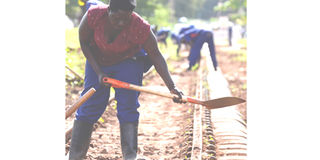Prime
Locals want works on old railway as SGR hopes fade

Workers rehabilitate the railway line in Kampala on April 5. The standard gauge railway is yet to be constructed. PHOTO | FILE
A section of residents in Busoga Sub-region have asked government to refurbish the old railway line instead of waiting for the standard gauge railway (SGR).
The SGR in Uganda was launched in 2014, and is meant to replace the old metre gauge to ease transportation of goods between Mombasa, Kampala and Kigali (Rwanda), among other countries and create jobs.
Although the project was expected to be completed within 42 months, it has suffered setbacks .
Mr Robert Owere, a resident of Kizuba Village, Kizuba Sub-county, in Namutumba District, said the government in 2018 suggested that the SGR will take a lot of time to complete because it has to first wait for Kenya SGR to reach the Malaba border.
Mr Owere said since then, there have not been efforts to show government’s commitment to commence its construction or revamp the old railway line.
The residents’ concerns come after a train from Tororo District heading to Iganga on September 3 derailed from its tracks at Nawansega Village, Namungalwe Sub-county in Iganga, destroying property.
Residents said eight containers fell off from the train.
A week after the incident, the train’s wreckage was still at the scene, infuriating businessmen who accused Uganda Railways Corporation (URC) of laxity in relocating the wreckage to Inland Container Depots in Kampala.
Mr Stephen Wakasenza, a URC official, said their first intervention was to repair the damaged line to allow other trains in transit to proceed.
He added that they needed two cranes to lift the containers and when they eventually came, the persistent rains hampered their efforts.
The plan to build SGR was further delayed by the Covid-19 pandemic which affected the Chinese economy, the project financers.
Mr Kawanguzi Mutaka, the chairman of Kigalama Village in Namutumba Sub-county, said many people lost jobs, local revenue reduced and insecurity increased in the region.
Mr Mutaka added that businesses such as fish mongering at Budumba Swamp in Butaleja District and at Jinja Source of the Nile, and lodges closed.
“People who used to sleep in lodges and buy fish were passengers from Kenya. However, such businesses collapsed, creating unemployment,” he said.
Mr Mutaka added that if the government had embarked on modernising the old-metre gauge railway line, many jobs would be created.
The Kizuba Sub-county chairperson, Mr Badru Sindani, urged government to use the loan acquired from Exim Bank of China to revamp the old railway, saying the SGR might take another 10 years to construct.
However, the loan is yet to materialise after government’s request was rejected. Uganda re-submitted the loan application after changing the scope of works and revising the cost for the 273km project reduced by $26 million to $2.269 billion.
China insists there must be clarification on whether Kenya’s SGR will end at the border to guarantee smooth connectivity.
Residents are also requesting district authorities to allow them use the SGR land for farming.
SGR officials in March asked security agencies to evict people who have encroached on land under the proposed railway corridor, saying the move will address all encumbrances that may frustrate commencement of the project works. ‘‘We are dismayed that some of the project affected persons that had even received their compensation have returned to the land to grow crops while others are using it for brick making,’’ Mr Emmanuel Ssemakula, the deputy project coordinator of technical works at SGR, said then.
Last month, President Museveni warned Ministry of Works technocrats against manoeuvres to disband the SGR project, which he described as government’s other “greatest priority” alongside electricity.
He directed the Works and Transport minister, Gen Katumba Wamala, to rein in on officials in the ministry who have been scheming to undermine the SGR secretariat.
“Instead of disbanding it, a budget should be found to complete the compensation so that the right of way is acquired and concluded,” Mr Museveni stated.
He added: “The negotiations with the Chinese should be completed. The CHEC Chinese Company was ready after stopping the thieves that wanted bribes.”
Gen Katumba said the SGR was conceived as a regional project and, therefore, requires input from the regional government for its implementation.
Background
The first section of Uganda’s SGR is expected to run 273km from Malaba to Kampala at a cost of $2.1b. Uganda’s SGR will only be viable after Kenya completes its remaining sections—266km line from Naivasha to Kisumu port at a cost of $3.6b (Shs13t), and later the 107km line connecting to Malaba expected to cost $1.7b (Shs6t).
Uganda and Kenya first agreed to construct the SGR in 2008 but the arrangement was not concretised until 2012. By then, Kenya was on the last stages of negotiations with China for the Mombasa-Nairobi SGR line, whose loan was released in 2014. Uganda’s SGR was launched in 2014.



